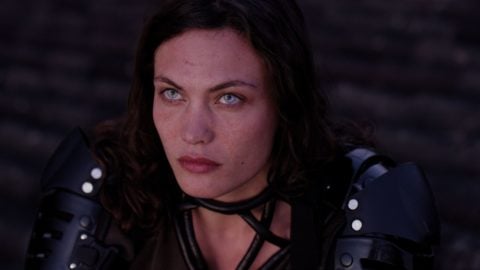Interview: Caroline Poggi & Jonathan Vinel
Jessica Forever screens Friday, February 8 at Film Society of Lincoln Center as part of Film Comment Selects.
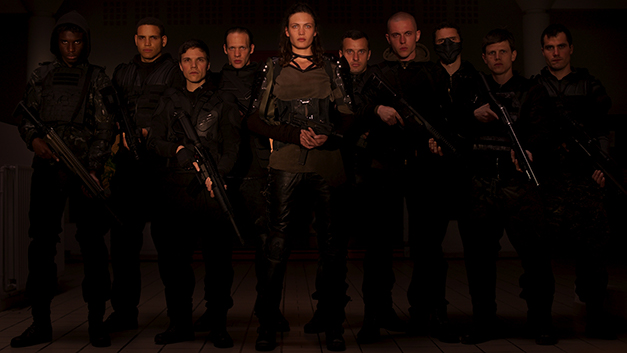
Since the Golden Bear-winning As Long as Shotguns Remain (2014), directing duo and real-life couple Caroline Poggi and Jonathan Vinel have established their own brand of art-house filmmaking through a string of hypnotic shorts capturing the turmoils of youth against Southern France’s suburban wastelands. Blending a hyperreal vision of the everyday with bursts of violence and sensuality, Poggi and Vinel’s short film collaborations—As Long as Shotguns Remain, Our Legacy (2015), and After School Knife Fight (2017)—find a rich, genre-bending synthesis in their dystopian debut feature, the ensemble-led Jessica Forever (2018). Reminiscent of video games with its tactile, tightly composed visuals and hazy temporality, the film follows a warrior tribe of teenage dropouts from society and their beloved guardian angel, the half-maternal, half-martial Jessica (Aomi Muyock). Despite efforts to move away from their criminal past and reinvent themselves together, the young men are faced with the continuous threat of annihilation by government forces—futuristic drones that hang over the action like a cloud of impending doom.
I spoke with Caroline and Jonathan over coffee in Paris in anticipation of Jessica Forever’s screening at Film Comment Selects on February 8.
What made you guys want to co-direct when you crossed paths in college?
JV: Caroline was making a short called Chiens, and I was in my first year at La Fémis, where I was also making a short. We started giving each other feedback on our films and one day, we just said: “Come on, let’s write a film together.”
CP: We were attracted to the same things, had a lot in common, and were helping each other with our films. At some point, we were naturally inclined to try something out together.
JV: Caroline and I come from similar places. She’s from Corsica and I’m from Toulouse, and we both grew up in suburban neighborhoods where we would get very bored.
CP: Our films indirectly talk about us and our adolescence. Someone said to me that Jessica Forever felt like we were opening the door of our teenage bedrooms. For example, our first short, As Long as Shotguns Remain, was shot in Jonathan’s native village and was the product of conversations about mourning and local news. So we were no strangers to each other’s stories.
JV: It’s the same with Jessica Forever, which was shot in Corsica and Toulouse. The roof on which Jessica sits in the opening shot is the roof of my house, and the secondary school at the end is where I went to school.
How did you feel about infusing those familiar places with an apocalyptic edge?
CP: It was more about immortalizing them. When you make your house into the place where Jessica gazes at the sky and senses something happening around, you are like a kid re-enchanting your world. And that’s wonderful, because everything you dreamed of when you were a kid can come true in the span of a film, including your vision of school as a place of ritual, contemplation, and fiction. Taking extremely familiar things and placing them in another world to have them exist differently is something I love profoundly and which speaks to the core of our cinema.
Jessica epitomizes the film’s tension between concreteness and abstraction. Her body language, voice, and clothing make her palpable, but we don’t know anything about her except her mission. Did you provide the actress, Aomi Muyock, with further information, or was it important for you that she retain an abstract quality as a mythological personification of motherhood?
JV: There are things about Jessica that were present in the script but did not make it into the film. In the script, the boys came up with legends about her and each had a different point of view: one said that she had been raised by a wizard, another that she was initially a monster and had converted herself—everyone had invented their own myth, but there was no answer. As for us, we’ve always seen Jessica as a sort of goddess or an angel fallen from the sky with the mission of helping these boys.
CP: But I also remember we told [Aomi] not to be too maternal and wanted her to resemble more of a big sister or a muse. In real life, Aomi is very different from Jessica, so her becoming the character had a lot to do with physical demeanor: how she walked, stood, gazed, spoke. We wanted her to have a mystical, mythological quality. There had to be something untouchable and undefinable about her, something magnetic. And that’s what I like in Jessica, the fact that you don’t really know who she is. She is simultaneously very present and far away, as though from another planet.
JV: When Aomi comes into a room, she radiates something powerful but at the same time impalpable. We needed an actress who could embody [Jessica’s] mystery, someone with a powerful enough aura to make herself remembered at all times. Jessica is definitely not the film’s main character: she speaks very little and has few scenes. But she is always there, because her presence is the very condition of the boys’ existence.
What was the casting process like?
CP: Casting has always made me uncomfortable because of the idea of judging someone. On Jessica Forever, we did a true casting that took a tremendous amount of time with Kris Portier de Bellair, [Bertrand] Mandico’s and Haneke’s casting director. Jonathan and I met everyone [who auditioned] for an hour to talk about life, and we learned so much about their personalities just by talking to them. Then we called back the people we liked for a reading and took the time to rehearse with them, because you can’t just hand a script to someone and expect them to step into your world.
JV: It’s important for us to pick people who already correspond to the roles and don’t have to go through an immense transformation. For Jessica Forever, we met a lot of non-actors whose pictures we had seen on Instagram and found interesting. So we ended up with a mixture of professional actors and people who had never acted before. It was easier to cast the girls because they are three, and we had a pretty clear idea of what we were looking for. When we were auditioning the boys, we wouldn’t tell them which part it was for because we didn’t know either, and it was a delicate balance of making sure they didn’t look alike. It’s only on the first day of shooting that we saw them all together—it was impossible to gather them before because they come from different places and social backgrounds. We really feared they wouldn’t get along since they’re so different, but they became very close and remained together all the time.
Did you put the actors through a physical training?
CP: Yes, we had those who were in Paris do some Systema [a Russian martial art]. It was wonderful, because it helped break down barriers between them. I think once you touch someone [physically], it becomes a lot easier to talk to them or be silent in their presence. And that’s also the story of the film: people who come together in an act of resistance.
JV: All the actors did this film because they wanted to, not for money or career purposes. Everybody was paid the same, and since there were no main characters, there was no hierarchy either, which really helped create the sense of a group.
How did you choose Jessica’s costumes, which marry a medieval style with an ultra-contemporary one to imbue the character with a timelessness?
CP: We had thousands of visual references spanning fashion and video games, and our costume designer, Sarah Topalian, made a lot of the costumes herself. There was also the idea that the film doesn’t take place in the real world and is more of a myth. So the costumes reflect this [discrepancy]. I remember Aomi told me that having a costume that doesn’t resemble her was helpful in stepping out of herself and into the world of the film.
JV: It was important that the costumes tell a story about the characters and for there to be no hierarchy of clothing, in the sense of combining expensive things with cheap ones. We had very long dress rehearsals with the actors and chose their costumes instinctively in terms of their place in society.
CP: It was the same for the gifts [Jessica gets for the boys]. There was the idea that a sweatshirt is as important as a piece of leather clothing.
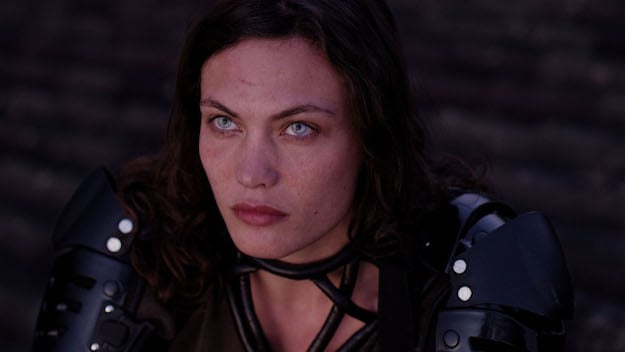
Jessica Forever is an aesthetic and thematic extension of your shorts. How much did you draw on your short filmmaking practice and how did you experience the challenge of weaving a story across time?
CP: It’s natural to want to move to feature filmmaking after making several shorts. In our case, it was being at the Berlin Film Festival in 2014 with our first short, As Long as Shotguns Remain, that gave us the impetus to start writing Jessica Forever. While writing and preparing the feature, we were both still film students and continued making shorts on the side, so everything kind of happened simultaneously. For instance, our last short, After School Knife Fight, was made during Jessica Forever’s casting.
JV: It took us a long time to write Jessica Forever, because we were not used to telling very structured stories. We knew that a feature would require a more heightened audience engagement than a short, and that’s something that made us really nervous, because we didn’t want to fall into narrative traps. You can write a script pretty quickly by following a screenwriting kit. But we wanted to tell the story of a group instead of a single protagonist, and make a film with a constellation of characters who together form a whole. That’s why we struggled to give birth to this script.
How did you collaborate with your writing partner, Mariette Désert?
JV: Mariette acted more as a script consultant to us.
CP: We went to see her every four months, and she gave us feedback on our writing and helped us not to lose our way.
JV: And since she had co-written Virgil Vernier’s Mercuriales, we knew that she was open to the idea of a strange kind of cinema and not a proponent of formatted storytelling. Given that it was our first feature, we had very strong desires and really wanted to do what we had thought up without having to fit into a narrative model. It’s always complicated, because our films operate on a sensory level, so what is very narrative to me may not seem that way to a viewer. A lot of people who saw Jessica Forever criticized it by saying: “There’s no story. It’s just a succession of images.”
CP: It’s a contemplative form of narration that pulls you in, so you have to agree to enter the film. I think it’s difficult to judge it according to classical narrative patterns, because a character dies 20 minutes into the movie and things shift after that. We were very keen on telling our story in a non-classical way, so we really had to find the heart of it, which was the idea of the collective. How do you live together, how do you bond, how do you mourn death—questions that our short films were already concerned with. And in that sense, Jessica Forever is like a synthesis of all the work we’ve done up until now.
The film is filled with key visual moments and musical montage sequences that must have been meticulously storyboarded. Did you have a clear idea of the architecture of scenes while writing the script?
JV: We don’t do storyboards because we don’t know how to draw. [Laughter] But we do a very precise visual breakdown with the cinematographer, so we know exactly what images we will be filming. We complete the breakdown after we lock the locations, and that way, we can really focus on the actors during the shoot. On Jessica Forever, it took a very long time to do the breakdown, which included a lot of visual references. A common problem in filmmaking is that there’s never enough budget or time for all the required shots. That’s why preparing so extensively allows us to get as much stuff as possible.
CP: When we’re writing, we use key images for lighting, tone, sensation, which nourish the script.
JV: We’ve always had a desire to produce strong visuals. But we don’t want to make images for images’ sake, so we look for the story within them. That’s why I’m a bit sad when people say what we do is visual and cool, because it seems to me that when we compose a shot, it’s with the intention of showing something in a new light, not with that of making something pretty.
I couldn’t help but wonder where Jessica finds the money to buy such expensive gifts for the boys—does she steal it? I began asking myself practical questions after Lucas and Michael’s visit to the shopping mall. It’s a rupture in the film that makes you question the rules of this dystopian universe and its relationship to our contemporary real world. Where do you situate the border between the two?
JV: That’s a complicated thing to explain, because the film does take place in our world, but in a tiny bubble inside of it. And it’s not sci-fi, because it takes place in the present. So it was interesting for us to have these super realistic moments, such as when [Lucas and Michael] go grocery shopping, because it was a way of tuning the characters into the world.
The transition to real life is echoed by a physical transformation: they take off their warrior costumes and put on civilian clothes.
JV: Yes, because they’re aware of being in the world but they’re also aware that they’ve never been part of it. They know it exists, but they also know they are completely out of it.
CP: In terms of money, there was a scene in an older version of the script that explained it. They would steal, right?
JV: There was a scene in which they stole stuff from stores at night. But I think we thought of money as something that was never missing from the characters’ [lives]. They have so much of it that it’s not important for them. That’s why there’s no hierarchy between the gifts: [the character] who receives a jet ski is not happier than the one who receives sunglasses—the gift’s expensiveness doesn’t make it better.
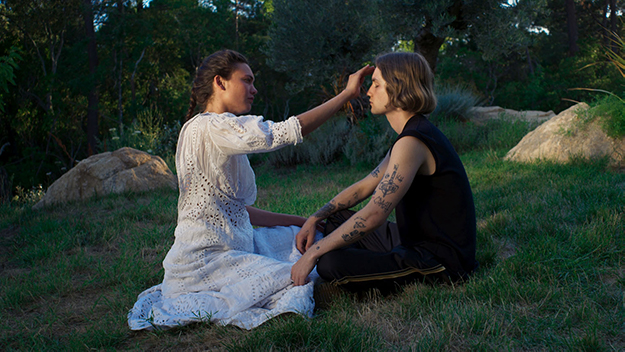
How did you conceive the tableau shots, like Kevin’s ceremony of integration? Do you work out the interplay of bodies in the frame in advance?
CP: We did that scene on the first day of the shoot. We had already mapped it out visually and the rest happened on spot. Once the actors are in costume, it comes down to [logistical] things like taking into account their heights.
JV: We had a breakdown and precise references for the lighting, but that was the first time we were seeing all the actors in the frame together. So we had to make some adjustments.
CP: I think it was a beautiful scene to begin the shoot with, because it shows the creation of a member of the group and therefore everyone had to act in synchronicity.
JV: Initially, there were many more shots in that scene. We usually do a lot of shots but never keep them all, because there’s only one that gets to the heart of the scene. It was the same for Julien’s funeral on the beach, which was originally a very edited scene, with at least 20 shots. [Now there are only two.]
CP: We were looking for a way to [foreshadow] the disruption that occurs in the group after Julien’s death. Since Raiden is the character who malfunctions right after, there were a lot of shots of him. But we eventually decided to get rid of them, because what’s beautiful in death is not sadness or people crying, but the paralysis it creates. If you look carefully at the funeral scene and what comes after, it’s all still shots in which everyone is paralyzed, and the first to move again and revive the action is Raiden.
JV: These are things you uncover at the editing phase, and we often rewrite the story there. For instance, the protagonist of As Long as Shotguns Remain originally committed suicide at the end by jumping off the roof. But in the edit, we decided not to use that shot and to make him disappear [by dissolving him] while he eats a bowl of cereal. We thought it was so much more beautiful to say: “Death is someone who was here but is no longer so.”
CP: Death is the void created by a person. You would expect death to be equal to visible suffering, but in Jessica Forever, it was clear the characters wouldn’t cry in the face of death because that just doesn’t match their way of being.
The soundtrack also contributes to the nightmarish feel through its fusion of metal, electronic, and baroque music. Did you write with specific songs in mind?
JV: We write with a lot of music, but the only song that was chosen in advance is the one the characters dance to in the garden, “The Great Leveller” by Jesu. We come to the edit with a selection of songs that we have an intuition about and then we test them on the image. I used to be a bass player in a metal band, so the songs we put in our films reflect our tastes, and music is what inspires us to do certain scenes.
CP: Sometimes when people read our scripts, we want to tell them: “Read this scene while listening to that song.”
JV: It’s funny, because I almost feel like we’re more connected to some kind of musical trend today than a cinematic one. People often appreciate and understand our films through their soundtracks—it’s something we are frequently asked about after screenings.
CP: We consider music as a character of its own. It’s not there to fill gaps, but to contribute to the storytelling. That’s why we like having a variety of styles, because each conveys a different emotion.
How did you envision the murderous drones and what did they entail in terms of VFX?
JV: We really wanted realistic drones that looked like ones you can buy on Amazon, but also for them to have a warrior quality.
CP: We wanted them to evoke wasps and react in an autonomous way without giving the impression that they were piloted. They had to have a robotic, contemporary look, but also a mythological one. That’s why they are equipped with blades and other things without functional purpose, because we wanted to summon a certain type of medieval imagery. It’s like with the boys’ armors—we densified them by adding small elements. This is something that really comes from video games: when you look at the costumes, there are a lot of unnecessary things added to enhance the warrior aesthetic.
JV: It was the first time we did VFX, so we were not well prepared, and post-production was delayed tremendously.
CP: Doing VFX is like doing a second shoot with non-existent actors, but we didn’t know how the whole process worked. There are a lot of things I can master, including costumes, but put me in front of a VFX machine and I know nothing. So we were really dependent on the people who did the work for us and it was the most complicated step in the making of this film. How do you explain to someone else what you have in mind when you don’t know the tools you are working with? Even Jonathan and I don’t have the same thing in mind—we can show each other as many references as we like, we will never be exactly on the same page. So how do you get there with a third person? You can ask an actor to be calmer. But you can’t ask a computer that, because it deals with gravity, speed, and whatnot. We learned a great deal on the spot, and that was painful on top of the pressure of finishing the film, which was our first produced one and came with a set of new rules.
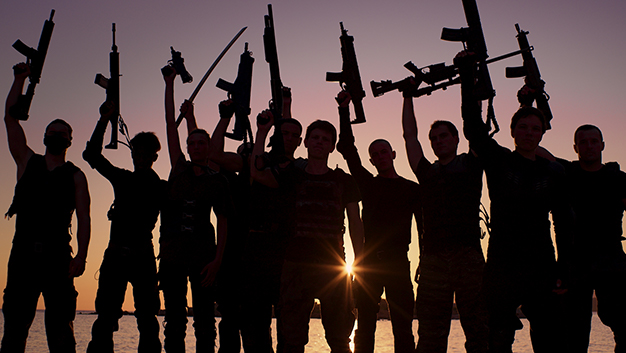
I love the last sentence of the “manifesto” you wrote with Bertrand Mandico and Yann Gonzalez for the Cahiers du Cinéma, which says that your films gather in the woods to dance around a fire until dawn. It’s a beautiful way of implying that your movies are living organisms and stem from obsessions that haunt you in spite of yourselves.
JV: I feel like a movie is a living character who should be given the opportunity to speak and express itself. That’s why I think Jessica Forever is a film that must be experienced with the stomach rather than with the intellect. People go far in analyzing things and ask themselves too many questions, but in reality, what we’re trying to do is very simple. For me, our films are made for children, in the sense that they’re meant to be processed very simply, with sensations.
CP: I always saw Jessica Forever as one of those paintings with a saint in the middle and different episodes around that compose the legend of his life. There’s something I always look for in art, be it cinema, music, or video games, which is the ability to be teleported into the work. When I leave the theater feeling like I was not there for a moment, it’s a triumph. I have traveled and forgotten myself, and perhaps this abandonment will help me come back to life in a better state and feel certain things more deeply. In video games, you get to look at the environment in a way that you don’t in real life, because it’s beautiful and magical. But this leap into the game also allows you to live and experience things differently. In the end, it’s about reconnecting better through disconnecting.
Translated by Yonca Talu.
Yonca Talu is a filmmaker living in Paris. She grew up in Istanbul and graduated from NYU Tisch.



